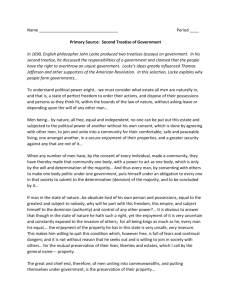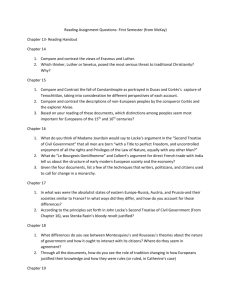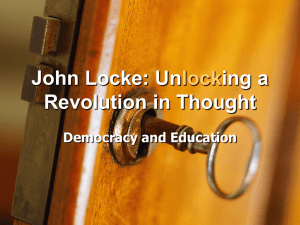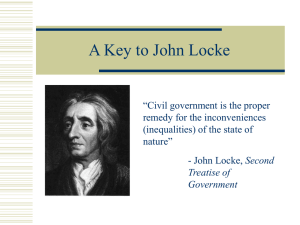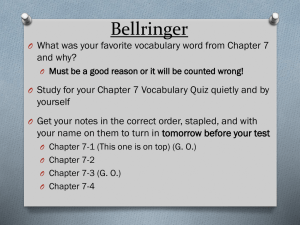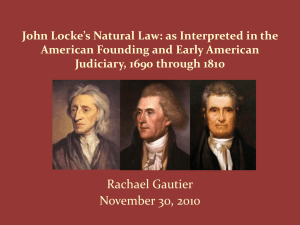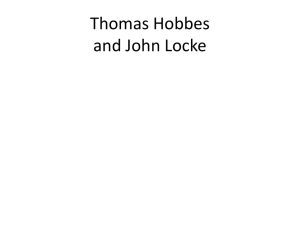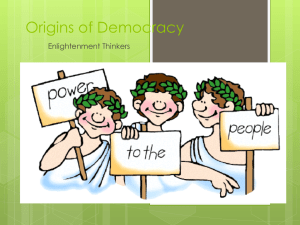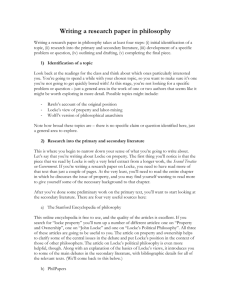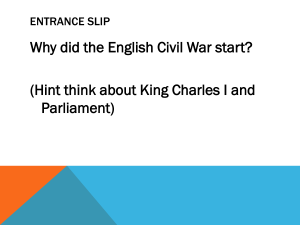PP 04 Locke and the Justification of Revolution
advertisement
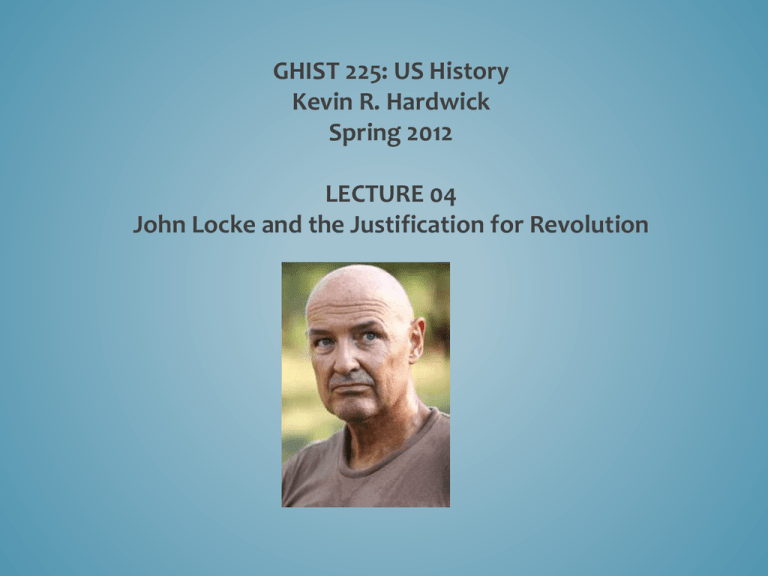
GHIST 225: US History Kevin R. Hardwick Spring 2012 LECTURE 04 John Locke and the Justification for Revolution GHIST 225: US History Kevin R. Hardwick Spring 2012 LECTURE 04 John Locke and the Justification for Revolution Part One: Restoration to the Glorious Revolution Part Two: John Locke and the justification for the Glorious Revolution Time Line So Far: 1603 1625 1639-1649 1660 1685 1688 ______________________________________________ James I King James I Of England Dies, Charles I King of England English Civil Wars; Charles I executed Restoration; Charles II King of England Charles II Dies, James II King of England “Glorious Revolution” James II deposed William of Orange King of England “These are the Stuarts, hear their names: James and Charles, Charles and James” Key Idea: One important outcome of the Glorious Revolution was that henceforth, England was a Limited Monarchy, with a Mixed and Balanced Constitution This is the Constitution against which the American Colonies rebelled. Key Idea: Natural Law: there exists a set of universal principles governing human conduct, which can be discovered by human reason. These principles are timeless, and derive from our common nature as human beings. Key Idea: Natural Rights: Derive from natural law, and belong to us by virtue of our existence as human beings. They are neither created by nor distributed by the conventional arrangements of men, but rather come from God, and they are built into the nature of existence. Key Idea: Natural Rights: Because all just governments must respect natural rights, these represent 1.) things government must provide for us (entitlements) or 2.) things government cannot take from us, ie., limitations on what government can do. An example of an entitlement: criminal defendants have the right to a jury trial An example of a limitation on government: citizens cannot be imprisoned unless the government can show reasonable cause Key Ideas in John Locke’s Second Treatise: State of Nature: a “condition of perfect equality, wherein all the power and jurisdiction is reciprocal, no one having more than another.” French artist Henri Rousseau, “Exotic Landscape,” 1910 Key Ideas in John Locke’s Second Treatise: Natural Freedom: the capacity of persons "to order their actions and dispose of their possessions as they think fit, within the bounds of the law of nature, without asking leave or depending upon the will of any other man." Key Ideas in John Locke’s Second Treatise: The State of Nature sounds pretty good. So why would anyone want to leave the state of nature? “For though the law of nature be plain and intelligible to all rational creatures, yet men, being biased by their interest, . . . are not apt to allow of it as a law binding to them in the application of it to their own particular cases.” Key Ideas in John Locke’s Second Treatise: The State of Nature sounds pretty good. So why would anyone want to leave the state of nature? “For every one in that state being both judge and executioner of the law of nature, men being partial to themselves, passion and revenge is very apt to carry them too far, and with too much heat in their own cases, as well as negligence and unconcernedness, make them remiss in other men's.” Key Ideas in John Locke’s Second Treatise: Original Compact: the means by which people leave the state of nature and create an unnatural government—that is to say, a man-made government. To do this, we must give up some of our freedom to interpret the law of nature for ourselves. And likewise, we must give up some of our equality, since we delegate the enforcement of the law to other men. Key Ideas in John Locke’s Second Treatise: Consent: the Original Compact is premised on the rational consent of the people party to it. Government derives its authority not from God, but rather from the Consent of the People. Key Ideas in John Locke’s Second Treatise: Reason: Not the fundamental importance of human reason to Locke’s argument. "The Freedom then of man, and liberty of acting according to his own will, is grounded on his having reason, which is able to instruct him in that law he is to govern himself by, and make him know how far he is left to the freedom of his own will." Key Ideas in John Locke’s Second Treatise: Reason: Another example: "Absolute Monarchy is indeed inconsistent with civil society." Under an Absolute Government, the subject "has no appeal, as those in society ought to have, but, as if he were degraded from the common state of rational creatures, is denied a liberty to judge of, or defend his right, and so is exposed to all the misery and inconveniences that a man can fear from one, who being in the unrestrained state of nature, is yet corrupted with flattery and armed with power." Key Ideas in John Locke’s Second Treatise: Contrast the Absolutism of King James I with the Social Contract ideas of John Locke. To James, the people are his subjects. To Locke, the (adult, male, rational) people are citizens. Note the degree to which, for Locke, citizenship is premised on adult rationality.
